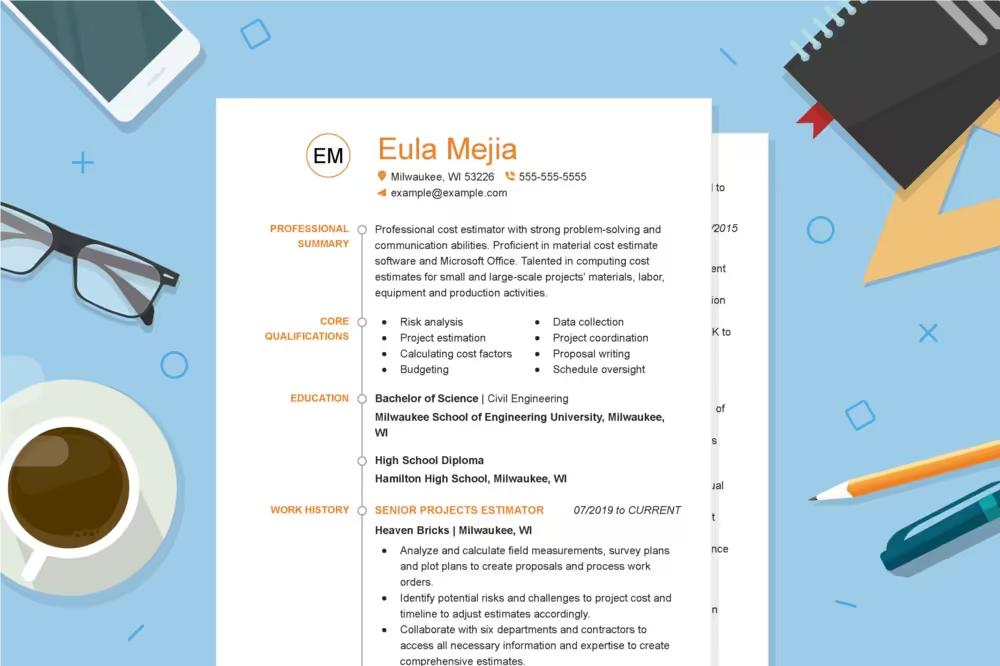The right CV format makes it easy for employers and admission committees to find key details like notable experience, publications, skills and key accomplishments. This article covers how to format your CV correctly and give you some examples of CV format.
Want a stronger resume? Try our CV templates. Simply edit and download. Plus, you can make a custom CV template and personalized sections with our CV Builder.
What Is a CV?
A CV, or curriculum vitae, is a multi-page summary of your academic and professional life. This detailed document averages two to three pages but can reach up to ten pages. With so much information, these CV format tips can ensure nothing gets overlooked.
CV Layout: Structure Your CV
Although CV formats are customizable, your document should always include these five sections. Let’s review them one by one.
1
Contact Information
This one is easy but no less important. Your contact information should be prominent at the top of your CV so the recruiter can contact you quickly.
Include the following information:
- Full name
- Professional title
- Phone number
- Address
- LinkedIn profile
2
Personal Statement
A personal statement is a short paragraph at the top of your CV highlighting your key skills, achievements and goals. It takes the shape of a professional summary or objective. Use keywords from the job description and action verbs to grab the reader’s attention quickly.
Here’s an example:
“Seasoned microbiology researcher specializing in food microbiology with a track record of academic achievements, including groundbreaking publications in the International Journal of Food Microbiology and contributions to scholarly discourse. Committed to advancing the field by unraveling the complexities of microbial interactions in food systems. Dedicated to deepening our understanding of food microbiology and enhancing food safety, quality and sustainability globally through rigorous inquiry and innovative methodologies.”
3
Work Experience
The work experience section of your CV can include your past roles and provide details on your responsibilities and accomplishments. Start with your most recent position and list your professional history in reverse-chronological order. When explaining your achievements, try using numbers to impress the hiring manager.
Here’s how it should look:
Food Microbiologist | NutriSafe Laboratories
Sacramento, CA | July 2019 – Present
- Developed and implemented new microbial testing protocols, resulting in a 20% reduction in testing time and a 15% increase in laboratory efficiency.
- Led a research project focused on identifying and characterizing foodborne pathogens in fresh produce, leading to the publication of two peer-reviewed articles in renowned scientific journals.
- Collaborated with the quality assurance team to establish corrective actions for microbial contamination issues, reducing product recalls by 25% within one year.
4
Academic History
Format your academic history using the following order:
- Degree title
- University name
- Dates
- Honors or thesis (if relevant)
Your cover letter format should look like this:
PhD in Molecular and Cell Biology | University of Maryland
College Park, MD | Graduation date: May 2019
5
Skills
Format your CV skill section in a simple, six-to-eight-item bullet list. Carefully read the job description and identify key skills the employer is looking for. Your CV may include multiple specialized skill sections related to the job opening.
For example, a food microbiologist might write:
General Skills
- Communication
- Report writing
- Critical thinking
- Time management
- Team collaboration
- Attention to detail
Research Skills
- Microbial identification
- Sterile technique
- Data analysis
- Food safety testing
- Lab equipment operation
- Sample preparation
6
Optional Sections
Since a CV is a complete look into your academic and professional history, a customizable CV format allows you to add multiple customizable sections. you can add many sections.
Here are a few:
- Awards and honors
- Publications
- Projects
- Certificates
- Extracurricular activities
- Professional organizations
- Languages
- Volunteering experience
PRO TIP
Most jobs requiring a CV are in law, academia, research, medicine and government. To stand out, we recommend adding publications and awards sections to your CV format. These CV examples demonstrate multiple combination options.
How to Format a CV
A well-formatted curriculum vitae can help you pass applicant tracking systems (ATS). This is the correct CV format for a job:
CV Format Examples
These CV format templates will ensure your curriculum vitae checks all the boxes and impresses the hiring manager.
Need help finding what you are looking for? Check out our complete library of CV templates to find the best one for you.
Simple CV format
Professional CV format
Creative CV format
How to Choose the Best CV Format
There are two CV formats to choose from. Select the one that best suits your career goals:
1Chronological CV format:
The chronological format focuses on your work experience. Candidates with a rich professional history will stand out and most likely pass an ATS test.
2Functional CV format:
The functional format works well for job seekers changing careers, with employment gaps or new to the job market, as it highlights their skills. It is less likely to pass an ATS test, but it helps you stand out if you have minimal work experience.
Key Takeaways
Let’s go over some key takeaways now that you have all the necessary information to write a letter of interest for a job:
CV Format FAQ
What is the difference between a CV and a resume?
A CV and a resume differ in four ways:
- Purpose: In the U.S., a CV is typically only used to apply for academic, research, law and medical roles, while a resume is used to apply for most jobs.
- Location: Most employers will ask for a CV outside the U.S. and Canada instead of a resume.
- Focus: A CV showcases your entire academic and professional history, while a resume summarizes your work experience and qualifications to give the employer a snapshot of your career.
- Length: CVs can be up to five pages long, while a resume should be one page only.
How do I write a CV?
Our complete CV writing guide has all the tools and tips you need to create a top-notch curriculum vitae.
What is a simple CV format?
A straightforward CV format has the following elements:
- Professional header with contact information
- Personal statement
- Professional history
- Academic experience
- Skills section
- Publications
- Awards and honors
- Optional sections: certifications, conferences, professional affiliations, languages and volunteer work







